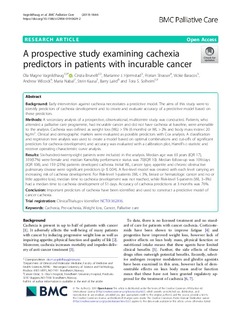| dc.contributor.author | Vagnildhaug, Ola Magne | |
| dc.contributor.author | Brunelli, Cinzia | |
| dc.contributor.author | Hjermstad, Marianne Jensen | |
| dc.contributor.author | Strasser, Florian | |
| dc.contributor.author | Baracos, Vickie | |
| dc.contributor.author | Wilcock, Andrew | |
| dc.contributor.author | Nabal, María | |
| dc.contributor.author | Kaasa, Stein | |
| dc.contributor.author | Laird, Barry J | |
| dc.contributor.author | Solheim, Tora Skeidsvoll | |
| dc.date.accessioned | 2019-12-06T09:18:38Z | |
| dc.date.available | 2019-12-06T09:18:38Z | |
| dc.date.created | 2019-09-16T12:48:32Z | |
| dc.date.issued | 2019 | |
| dc.identifier.citation | BMC Palliative Care. 2019, 18:46 1-10. | nb_NO |
| dc.identifier.issn | 1472-684X | |
| dc.identifier.uri | http://hdl.handle.net/11250/2632115 | |
| dc.description.abstract | Background
Early intervention against cachexia necessitates a predictive model. The aims of this study were to identify predictors of cachexia development and to create and evaluate accuracy of a predictive model based on these predictors.
Methods
A secondary analysis of a prospective, observational, multicentre study was conducted. Patients, who attended a palliative care programme, had incurable cancer and did not have cachexia at baseline, were amenable to the analysis. Cachexia was defined as weight loss (WL) > 5% (6 months) or WL > 2% and body mass index< 20 kg/m2. Clinical and demographic markers were evaluated as possible predictors with Cox analysis. A classification and regression tree analysis was used to create a model based on optimal combinations and cut-offs of significant predictors for cachexia development, and accuracy was evaluated with a calibration plot, Harrell’s c-statistic and receiver operating characteristic curve analysis.
Results
Six-hundred-twenty-eight patients were included in the analysis. Median age was 65 years (IQR 17), 359(57%) were female and median Karnofsky performance status was 70(IQR 10). Median follow-up was 109 days (IQR 108), and 159 (25%) patients developed cachexia. Initial WL, cancer type, appetite and chronic obstructive pulmonary disease were significant predictors (p ≤ 0.04). A five-level model was created with each level carrying an increasing risk of cachexia development. For Risk-level 1-patients (WL < 3%, breast or hematologic cancer and no or little appetite loss), median time to cachexia development was not reached, while Risk-level 5-patients (WL 3–5%) had a median time to cachexia development of 51 days. Accuracy of cachexia predictions at 3 months was 76%.
Conclusion
Important predictors of cachexia have been identified and used to construct a predictive model of cancer cachexia. | nb_NO |
| dc.language.iso | eng | nb_NO |
| dc.publisher | BioMed Central | nb_NO |
| dc.rights | Navngivelse 4.0 Internasjonal | * |
| dc.rights.uri | http://creativecommons.org/licenses/by/4.0/deed.no | * |
| dc.title | A prospective study examining cachexia predictors in patients with incurable cancer | nb_NO |
| dc.type | Journal article | nb_NO |
| dc.type | Peer reviewed | nb_NO |
| dc.description.version | publishedVersion | nb_NO |
| dc.source.pagenumber | 1-10 | nb_NO |
| dc.source.volume | 18:46 | nb_NO |
| dc.source.journal | BMC Palliative Care | nb_NO |
| dc.identifier.doi | 10.1186/s12904-019-0429-2 | |
| dc.identifier.cristin | 1725082 | |
| dc.description.localcode | Open Access This article is distributed under the terms of the Creative Commons Attribution 4.0 International License (http://creativecommons.org/licenses/by/4.0/), which permits unrestricted use, distribution, and reproduction in any medium, provided you give appropriate credit to the original author(s) and the source, provide a link to the Creative Commons license, and indicate if changes were made. The Creative Commons Public Domain Dedication waiver (http://creativecommons.org/publicdomain/zero/1.0/) applies to the data made available in this article, unless otherwise stated. | nb_NO |
| cristin.unitcode | 1920,12,0,0 | |
| cristin.unitcode | 194,65,15,0 | |
| cristin.unitname | Kreftklinikken | |
| cristin.unitname | Institutt for klinisk og molekylær medisin | |
| cristin.ispublished | true | |
| cristin.qualitycode | 1 | |

